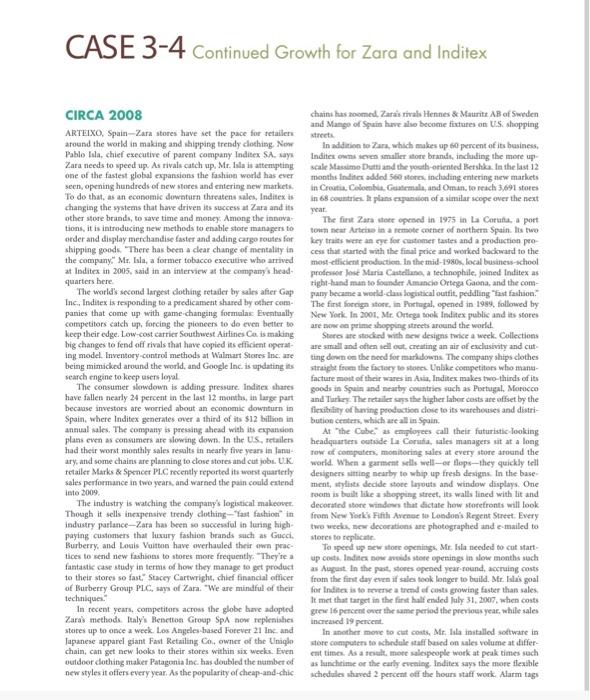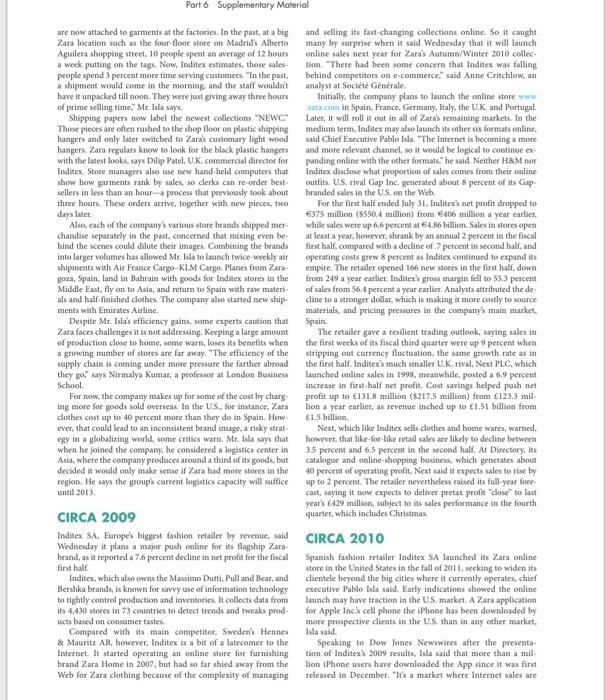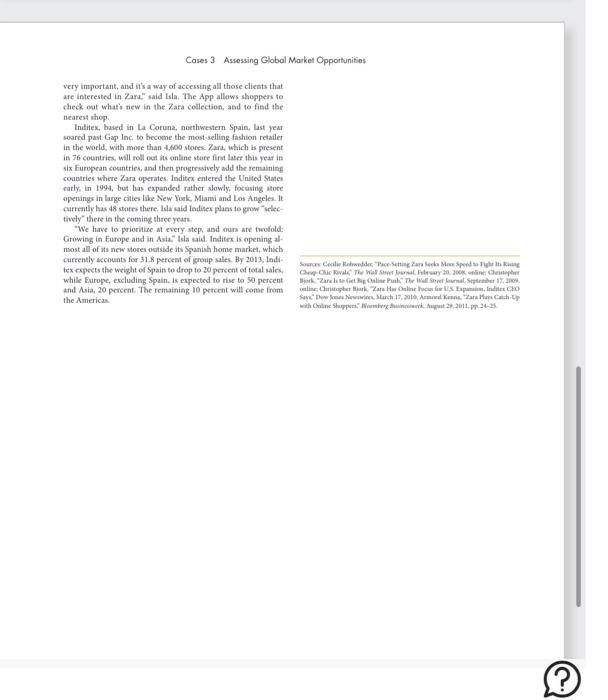1. what are the important attributes of a "fast fashion" retailer to customers? What are the important attributes to store managers?
2. what are the ways that Inditex ensures the "fast fashion" is truly fast?
3. why would a retailer introduce their online store country by country? Why was Inditex slow to embrace online sales when they are so tech-savvy in other ways?
4. Briefly describe three opportunities for continued growth during the next five years for Zara's parent, Inditex,S.A. and outline the advantages and disadvantages of each.
CASE 3-4 Continued Growth for Zara and Inditex CIRCA 2008 ARTEIXO, Spain-Zara stores have set the pace for tetailen around the world in making and shipping trendy cloching. Non Pable tala, chief executive of pareat company Inditen SA, says Zara needs to upeed up. As rivals catch up. Mr. Wla is attempting one of the fastest global expansians the fashion world has ever seen, opening hundreds of new stores and entering new markets. To do that, as an economic downturn threatens vales, Inditex is changing the systems that have driven its success at Zara and its other store brands, to save time and money. Among the insovar tions, it is introducing new methods to enable store managers to order and display merchandise faster and adding cargo routes for shipping goods. There has been a clear change of mentality in the compuny" Mr. Isla, a former tobacco executive who arrived at Inditex in 2005, said in an interview at the companys headquarters bere. The world's second largest dothing retaller by saies afier Gapp Inc., Inditex is responding to a predicameat shared by other conspanies that come up with game-changing focmulas Eventually competitors catch up, forcing the pioneers to do even better to keep their edge. Low-cost carrier Southwest Airfines Ca is making big changes to fend off rivals that have copied its efficient operating model. Inventory-control methods at Walmart Stores lac. are being mimicked around the world, and Google lnc. is updating its search engine to keep asens loval. The consumer slowdown is adding pressure. Indisca shates have fallen nearly 24 percent in the last 12 months, in large part because investors are worried about an economic downturn in Spain, where Inditex generates over a third of its $12 billion in anausal sales. The company is pressing ahead with its expandion plans even as consumers are slowing down. In the US, retailen had their wont monthly sales results in nearly five years is lanuary, and some chains are planning to close stores and cut jobs. U.K. retailer Marks \& Sprncer PL.C recently reported is wotst quarterty sales performance in two years, and warned the pain could entend inte 2009 . The industry is watching the company's logistical makeover. Though it sells inexpensive trendy dothing-- Tast fachion" in industry parlance-Zara bas been so succesuful in luring bight. paying customers that laxury fashion beasds sach as Gucd. Burberry, and Louis Vuitton have overhauled their own practices to send new fashioas to stores more frequently. "They're a fantastic case study in terms of hov they manags to get product to their stores so fast." Stacey Cartwright, chief financial efficer of Burberry Groap PLC, says of Zara. "We are mindful of their techniques:" In recent years, competitors across the globe bave adopted Zaras methods. tealyi Benettos Group SpA now replenisher steres up to once a week. Los Angeles-based Fotever 21 Inc, and Japanese apparel giant Fast Retailing Co, owner of the Uniqlo chain, can get new looks to their stores within six weeks. Even outdoor clothing maker Patagonia lnc. has doubied the namber of new styles it effers every year. As the popularity of cheap-and-chic Chainu has zoomed, Zarais rivals Hennes S Mauritt AB of Sweden and Mango of Spain have alwo become fixtutes on U.S. shopping strects. In addinine to Zura, which makes up to percent of its business, Inditer owmi seven smallier store brandta, including the more upscale Masuimo Duits and the youth-oriented Hershka. In the last 12 months inditer added 560 atores, inchading entering new markets in Croutia, Coloesbin, Geatermalh, and Omin, to resch 3,691 stores in 68 countries. It plans expunsion of a similar scope over the neat wear. The fint Zara stoer opesod in 1975 in L Cortuly, a port town near Artecise in a vermote cotner of northern Spain. lis two key traits were an rye for customer tastes and a production peocess that started with the final price and worked backovard to the most-etficient production. In the mid-1980x. local business-achool prodeneer lose Maria Castellusa, a technophile, joined Inditex as sight-hand man to foender Amancio Ortega Gaona, and the comaThe first forcign stoer, in Portugal, opened in 1989, followed by Nere lork. In 2001, Mr. Ortrga sook Inditex public and its stores are now ea prime shopping streets around the world. Stero afe stocked wich aew designs twike a week. Collections are small and often sell out, creiting an air of exclusivity and cut: ting down on the need for markdowns. The company ships clothes straigka focen the fuctiory to stoees. Unlike competitors who mansfacture moit of their wares in Ava, Inditex makes two-thinds of its goods in Spuin and nearby countries such as Portugal, Morocco and Turkey. The retailer sws the higher laher costs ate offset by the flexibtility of hming prodaction dose to its warchosses and distribution craters, which aze all in Spain. At "the Cube" as enoployees call their futuriatic Jooking headquarters outside La Conuha, sales managers at at a loag row of computen, monitoring wiles at every store around the world. When a garment sells well-or Alops-they quickly tell devigners aiming nearby to whip up fresh designs. In the base: ment, stylists decide stoet lopouts and window displays. One room is built like a shopping street, its walls lined with lit and decorated atore windown that sctate how storefronts will look from New Yoekis Fifth Arenee to London's Regent Strett. Every two weeks, aes decoerations are photographed and e-mailed to stores to replicate. To speed up new atoer openings. Mr. Isla needed to cut atartup costs. ladiaca now wuids stose opersings in slow months such as August In the past, stopes opened year-found, accruing costs from the fint day even if seles took longer to build. Mtr. Illis goal for Inditer is to reverive a trend ef custs growing fuster than sales. It met that target in the first half ended july 31, 2007, when costs grees 16 percent over the wame period the pperioss year, while sales increaced 19 percent. In another mone to clat coats, Mr. lala installed software in store compuaten to ochedule safif based on sales volume at different times. As a troult, mote sulespoople work at prik times sech as landhime of the early evening, Inditex says the more flexible wchedules shuved 2 percent off the houn staff work. Alarm tags are now attached to garments at the factories. In the past, at a big Zara loxation sach as the four-Goor store on Madrid's Alberto Aguilera shopping street. 10 people speat an average of 12 hours a week putting on the tags. Now, Inditex estimates, those salespeople spend 3 percent more time serving customers, "In the past. a shipment would come in the morning and the staff wouldrit have it unpacked till noon. They were just giving away three hours of prime selling time, Mr. Isla says. Shipping papers now label the newest collections "NEWC. These pieces are often rushed so the shop floor en plastic shipping hangers and only later switcled to Zaraik customary light wood hangers. Zara regulars know to look for the black plastic hangers with the latest Jooks, says Dilip Patel, U.K. commercial director for Inditex. Store managers also ese new hand-held computers that show how garments rank by sales, so clerks can re-order bestsellers in less than an hour - a process that previously took about three bours. These orders arrive, together with new pieces, two days later. Also, each of the company's various store brands shipped merchandise separately in the past, concerned that mixing even behind the scenes could dilute their images. Combining the brands into larger volames has allowed Mr. Isla to launch twice-woekly aif shipanents with Air France Cargo-K1.M Cargo. Planes from Zaragoca, Spain, land in Bahrain with goods for Indilex stores in the Middle East, fly on to Asia, and retam to Spain with rav materi. als and half-finished clothes. The company also started new ship. ments with Emirates Airline. Despite Mr. Isla's efficiency gains, some experts caution that Zara faces challenges it is not addressing. Keeping a large amount of production close to home, soene warn, loses its benefits when a growing number of stores are far away. "The efficiency of the supply chain is coming under more pressure the farther abroad they go, says Nirmalya Kumar, a professos at London Besines. School. For now, the company makes up for some of the cost by chang ing more foe poods sold overseas, In the U.S., for instance, Zara clothes cost up to 40 percent more than they do in Spain. How ever, that could lead to an inconsistent brand imagc, a risky strategy in a globalizing world, some crities warn. Mt. Isla says that when he foined the company, he considered a logisties center in Asia, where the company produces around a third of its goods, but decided it would only make sense if Zara had mote stores in the region. He says the group's carrent logistics capacity will suffice until 2013 . CIRCA 2009 Inditex SA, Europe's biggest fashion retaller by reveaue, said Wedsesday it plans a majoe push online for its flagship Zarar brand, as it reported a 7.6 percent decline in net profis for the fiscal first half. Inditex, which also owns the Massimo Dutti, Pull and Bear, and Bershka brands, is known for savvy use of information technology to tightly constrol production and inventorics. It collects data from its 4.430 stoces in 73 countries to detect trends and tweaks products based on consumer tastes. Compared with its main competitos, Swedenis Hennes \& Mauritz AR, bowever. Inditex is a bit of a latecomer to the Internet. It started operating an online store for furnishing brand Zara Home in 2007 , but had 50 far shied away from the Web for Zara clothing because of the complexity of managing and selling its fast-changing collections online. So it caught many by starprise when is said Wednesday that it will launch online sales next year for Zara's Autuma/Winter 2010 collection. "There had been some concern that Inditex was falling behind competitors on e-commerce," said Anne Critchlow, an analyst at Socie Gricrale. Initially, the company plans to launch the online store wwo marairom in Spain. France, Germany, thaly, the U.K. and Portugal. Later, it will roll it out in all of Zaras temaining markets. In the molium term, Inditex may alvo launch its other six formats online. said Chief Executive Pablo wa. The Internet is becoming a mote and more relevant chanel, so it would be logical to continie expanding online whth the other formats" he said. Neither H8M nor Inditex disclose what proportion of sales comes from their oaline outfits. U.S. rival Gap Inc. generated about 8 percent of its Giapbranded rales in the US, on the Web. For the first half ended July 31, Inditexis net profit dropped to 6375 million ( $550.4 million) from 406 million a year earlicr. while sales were up 6.6 percent at 4.86 billion. Sales in stares open at least a year, however, shrank by an ansual 2 percent is the fiscal first half, compared with a decline of .7 percent in second half, and operating costs grew 8 percent as Inditex continued to expand its empire. The retaller opened 166 new stoses in the first half. down from 249 a year carlier. Inditex's gross margin fell to 55.3 percent of sales from 56.4 percent a year earlier. Analysts attributed the de cline to a stronger dollar, which is makiag it more costly to source materials, and pricing pressures in the company's main market, Spain. The retailer gave a resilient trading outlook, saying sales in the first wecks of its fiscal third quarter were up 9 percent when stripping out currency fluctuation, the same growth rate as in the first half. Inditex's much smaller U.K. rival. Next PLC, which launched online sales in 1998 , meanwbile, posted a 6.9 percent increase in first-half net profit, Cost savings helped push net profit up to 6131.8 million (\$217.5 million) from 6123.3mil. lion a year earlier, as revenue inched up to fl.5t bilion from 61,5 billion. Next, which like lnditex sells clothes and home wares, warned, however, that like-for-like retail sales are likely to decline betwoen 3.5 percent and 6.5 percent in the second half, At Directory, its catalogoe and online-shopping beasiness, which generates about 40 percest of operating profit. Next said it expects sales to rise by up to 2 percent. The retaifer nevertheless raised its full-year forecast, saying it now expects to deliver pretax profit "close" to last year's 6429 million, subject to its sales performance in the fourth quarter, which includes Christmas CIRCA 2010 Spanish fashion retailer Inditex SA launched its Zara online store in the United States in the fall of 2011, seeking to widen its clientele bejond the big cities where it currently operates, chief executive Pablo Isla said. Early indications showed the online launch may have traction in the U.S. market. A Zara application for Apple lneis cell phene the iPhoee has been downloaded by more prospective clieats in the U.S. than in any other market. Isla said. Speaking to Dow Jones Newiwires after the presentation of Inditex's 2009 results, Isla said that more than a mil Lion iPhone users have downloaded the App since it was first reieased in December. "It's a market where internet sales are very important, and it's a way of accessing all those clients that are interested in Zara," said Isla. The App allows shoppers to check out what new in the Zara collection, asd to find the nearest shop. Inditex, based in La Coruna, neethwestern Spaie, last yeat soared past Gap lac. to become the most-selling fashion retailer in the woeld, with move than 4,600 stores. 7.20ra, which is present in 76 countries, will roll out its online stote fint later this year in six Furopran cosantries, and then progrosively add the remaining coustries where Zarn operates. Inditex entered the United States carly, in 1994, bet bas expanded rather slowly, forusing atore openings in large cities like New Yoak, Miani and Los Angeles. It carrently has 48 stores there. Isla said Indisex plans to grow "selectively" there in the consing three yeari. "We have to prioritize at every step, and ours are twofold: Growing in Europe and in Asia," Isla said. Inditex is opening almost all of its new stores outside its Spaniah home market, which currently accounts for 31.8 percent of jroup sales. By 2013, Indi. tex expects the weight of Spain to drop to 20 percent of total sales, while Europe, excluding Spain, is expected to rise to 50 percent and Asia, 20 pereent. The remainiag 10 pereent will cone from the Americas









